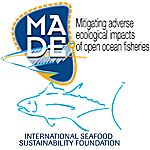Several pelagic species aggregate around floating objects and to date fishers have been more efficient in the exploitation of this behavior than scientists. Here we propose a new use of FADs: in addition to fishing aids, FADs could be used as scientific tools to collect data and improve our knowledge of pelagic ecosystems. Firstly, FADs concentrate pelagic diversity and therefore provide an excellent opportunity to investigate the pelagic biodiversity in a cost effective manner. We report results on biodiversity indices estimated from underwater visual census on FADs, compare them to observer data, and discuss how FADs could be used to monitor pelagic biodiversity. Second, FADs can be used to provide fishery-independent indices of the abundance of tuna and other associated species. The principle is very simple: the abundance of tuna (or other fish) associated with FADs within a region is related to the total abundance of tuna (or other fish) in the same region. However this relationship, as well as its dependence on the number of FADs, is not known. Here, we present a model on the behavior of tuna associated with FADs, which could provide insight into this relationship based on experimental measurements. This model could (i) provide local indices of abundance and (ii) predict the effects of increasing the number of floating objects on the ratio between the associated biomass and the total biomass. We discuss how the parameters of the model can be estimated through echosounder buoys and electronic tagging experiments.
- Presentation

 PDF version
PDF version
